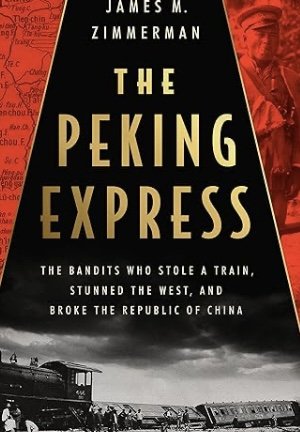The Peking Express by James M. Zimmerman ( Hachette Publishing Group)
Shanghai had a community of 35,000 foreigners in 1923 with many of them eager to travel on the newly launched express train to Peking. “A luxury hotel on wheels,” with its silk sheets and and its five-course banquets, the four-month-old train could make the 892-mile overnight journey in thirty-eight hours and attracted a multinational collection of affluent passengers.
On the morning of May 5, 1923, among those who boarded the train was an Italian attorney who represented the Shanghai Opium Combine, the owner of the Chinese Motors Federal Company who had left Romania penniless years before, a honeymooning couple from Mexico, a number of journalists, a couple of military families with their young children, and the aging sister-in-law of John D. Rockefeller Jr, heir to the Standard Oil Company.
At 2 am on May 6, over 100 passengers were kidnapped by 1000 bandits, who attacked and derailed the train. Although the victims were stripped of all their possessions, that wasn’t the goal of the man who was their leader.
Sun Mei-yao was a twenty-five-year-old former soldier who had amassed a large company of bandits and planned to use them in an “economic insurgency” against China’s warlords and the corrupt military general who governed the region. Shrewdly he decided that the best way to gain attention and achieve his goal of becoming a general himself, leading a brigade of former bandits, was to take hostages. The Peking Express, filled with wealthy Chinese and important foreign figures, was his ticket to success and he grabbed it.
Marching his captives to his stronghold on Paotzuku Mountain, Sun knew the grueling trek that would take several days was beyond the abilities of the women and children in the party. He gradually released them all--except for the Mexican bride who was from a country where banditry was commonplace and refused to leave her husband. (Eventually Sun lost patience and told a group of negotiators “And take the Mexican lady with you!”)
As released prisoners made their way to safety, they provided the necessary details that would capture the imaginations of newspaper readers all over the world. When Lucy Aldrich, the Rockefeller relative who was on her second journey around the world, emerged from captivity, her greatest fear was that her family would never let her travel again. She described her ordeal as “most dangerous,” yet “thrilling” and extremely amusing at times,” which probably launched 1000 headlines.
The remaining captives reached the bandits’ fortress and found “a beautiful quiet place with caves and the Temple of the Clouds.” “Our view is like an artist’s map,” one hostage wrote to his family. However it certainly wasn’t summer camp.
Their treatment was far from idyllic; beatings were not uncommon and three of the strongest men were separated from the others and isolated as bargaining chips on the least accessible part of the mountain. There these men found a group of 23 kidnapped children huddled in misery, like “hopeless hungry little old men.” Sick and near starvation, the group of boys and one girl were like a subscription service; their parents sent money each month to keep them alive. (The 47 children whose parents stopped sending ransom were thrown over the side of a cliff.)
Although foreign governments chose not to directly intervene in freeing the hostages because it was a matter for China to resolve, they sent doctors and supplies to the mountain and instituted an improvised postal system. Letters from the captives and replies from their families, 50-100 letters a day, were carried by visitors and the bandits, along with newspapers and cameras.
The hostages realized their only strength came from standing together, which kept Sun from using executions as a negotiation tactic. When they were finally released after five excruciating weeks, they made sure that the Chinese who had become part of their group were freed with them. Later all of the Chinese were brought to safety along with the imprisoned children.
Sun Mei-yao got what he wanted for a very brief time. When international attention veered away from the newly appointed brigadier general, he was beheaded, much to the rage of the men he had held hostage. The conditions of their release had been based on Sun’s safety and the violation of that infuriated his former prisoners, many of whom had come to respect him. So had Mao Tse-tung, who “admired Sun Mei-yao’s ability to mobilize the people.”
What came to be known as the Licheng Incident was perhaps the first use of international media to engineer worldwide public opinion. That it ended with much less bloodshed than the recent highjacking of a train in Pakistan is a sad commentary on current politics.
Later the Peking Express would become the Shanghai Express in a 1932 movie starring Marlene Dietrich and Anna May Wong. The screenwriter? None other than Harry Hervey, the pulp novelist and author of Where Strange Gods Call (Asia by the Book, April 2024).
The site of their captivity is now part of the Baodugo National Forest Park where a “rickety cable car” takes hikers to the foot of Paotzuku Mountain. If they can manage the ascent, they can sit where Peking Express hostages once waited to be released.~Janet Brown
